Qaballah Tree of Life
 To the right, you'll see a "Tree of Life" that I designed out of pipe cleaners. The fascinating thing about this particular depiction of the Tree of Life, is that it is three dimensional. Furthermore, I will show that it actually meets the description of the Golden Lampstand, or Golden Candlestick of the ancient Israelite Tabernacle, in a way that many common depictions of the Candlestick ultimately fail to do. The biblical description indicates seven lamps. A central shaft, with four sets of the "ornamentation" (which we will get into a bit later), with six branches coming out of it, three on one side, and three on the other side, each of those containing three sets of ornamentation as well. In total the number of sets of ornaments comes out to: 22, the number of letters in the Hebrew Alphabet. Anyone familiar with the Cabalistic Tree of Life will note that there are also twenty two paths connecting the Sephirot on the Tree.
To the right, you'll see a "Tree of Life" that I designed out of pipe cleaners. The fascinating thing about this particular depiction of the Tree of Life, is that it is three dimensional. Furthermore, I will show that it actually meets the description of the Golden Lampstand, or Golden Candlestick of the ancient Israelite Tabernacle, in a way that many common depictions of the Candlestick ultimately fail to do. The biblical description indicates seven lamps. A central shaft, with four sets of the "ornamentation" (which we will get into a bit later), with six branches coming out of it, three on one side, and three on the other side, each of those containing three sets of ornamentation as well. In total the number of sets of ornaments comes out to: 22, the number of letters in the Hebrew Alphabet. Anyone familiar with the Cabalistic Tree of Life will note that there are also twenty two paths connecting the Sephirot on the Tree.Additionally, we learn some particulars as to the arrangement. Namely, that one set of ornamentation (bowl, bud, and blossom) is found below where the first set of two branches split off from the main shaft, working our way up, we find another set below where the next two begin, and a third set is found below the final two branches.
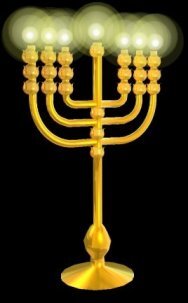 Depicted at the left, you see a typical representation of the candlestick. I say typical, but in reality you will hardly find two pictures that agree on the specifics, and that is precisely what I mean by "typical" ;)
Depicted at the left, you see a typical representation of the candlestick. I say typical, but in reality you will hardly find two pictures that agree on the specifics, and that is precisely what I mean by "typical" ;)However, there is one point which MANY depictions do agree on, and that is in relation to the placement of ornaments on the central shaft. One located below each set of branches, and by necessity, an elongated, unadorned top portion, capped by the final set of ornamentation where the central oil lamp is to be found.
The Tree of Life exhibits this same pattern in its central shaft. Three, equidistant orbs, a void, and then the crowning orb, "Kether", at the very top.
But, you may say, how can the Tree of Life be the Candlestick, since the Tree of Life only displays a central shaft with one branch on the left, one branch on the right? To answer this, we must enter the third dimension, and along our journey we will find out more about all the intricate intersecting pathways in the Tree of Life, and why some of them have Sephirot and some do not.
For simplicity, I have color coded my tree. The central shaft is red. The lowest set of branches is Blue, the next highest is Green, and the final set is Orange.
The Blue Branches
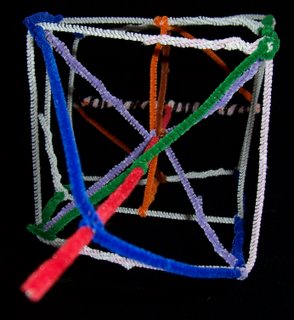
Here is a picture from the bottom of the tree looking up. I have not depicted the ornaments themselves, so I will describe where they are. [Maybe a reader can render this in 3D for me sometime, to help complement my crude pipe-cleaner model.] The first ornament rests just below the joint of the two blue branches and the red stick. The two blue and red branches "sprout" out of the blossom, and extend upward. You'll notice the blue goes to what I will call the South and North sides of the Tree, for it is placed chickenstance to the compass directions as explained by the first century Jewish historian, Flavius Josephus: "These lamps looked to the east and to the south, the candlestick being situated obliquely."
The Green Branches
The green, or second set of branches extend to the East and West, and just below the joint of their starting point is the second ornament. At this point, let us stop and take a collection of what remains. We now have a central shaft, with two sets of branches coming off of it, one in each of the four cardinal directions. If we were to view it from above as described so far, we would see nothing more than an X or + shape. Each of the extremities of this X shape extend directly upward and contain three sets of ornamentation, one at the base, one in the midst, and one at the top.
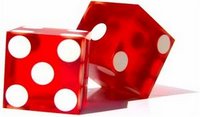 The central shaft contains four sets of ornamentation: One below each set of branches, and another one, located at the top, higher than any of the others. At this point, we have five lamps burning. Looking from directly above, compare it to the number five represented as the pips on a standard die. Each pip is where an oil lamp burnt, with the central one being higher than the other four.
The central shaft contains four sets of ornamentation: One below each set of branches, and another one, located at the top, higher than any of the others. At this point, we have five lamps burning. Looking from directly above, compare it to the number five represented as the pips on a standard die. Each pip is where an oil lamp burnt, with the central one being higher than the other four.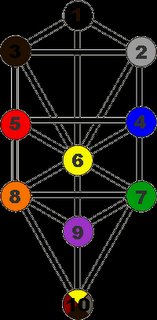 The top ornament on each branch, the place where the lamps burn, corresponds with the place beyond "Daath", the void between the upper three Sephirot and the seven found below it. So in the Lampstand, we could say that the upper three Sephirot are "on fire." With the left or right hand side, Chohman and Binah each containing two flames, one near to our point of view, and one back behind.
The top ornament on each branch, the place where the lamps burn, corresponds with the place beyond "Daath", the void between the upper three Sephirot and the seven found below it. So in the Lampstand, we could say that the upper three Sephirot are "on fire." With the left or right hand side, Chohman and Binah each containing two flames, one near to our point of view, and one back behind.The Orange Branches and the Snake
The Tree is sometimes associated with the Snake, a zigzag or a spiral concept. The final two branches, the "Orange" branches (as our pipe cleaners happened to be colored), are found coming forth from Tipereth, the Sun, the sixth Sephirot. The first ornament on each of these branches is found in a location half way between the second ornaments on the green and blue branches, and the second ornament is found half way between the third ornament of the green and blue branches, but the orange branches "spiral" around the top, so that they form the pathways reaching to the Crown, and cause the pinnacle of the left and right orange branch to be in perfect alignment with the flame at the top of the red central shaft.
 These three together are seen as a single point from the traiditional viewpoint, but it is actually a spiral similar to the old NCSA Mosaic logo, where the three "flames" are aligned in a straight row.
These three together are seen as a single point from the traiditional viewpoint, but it is actually a spiral similar to the old NCSA Mosaic logo, where the three "flames" are aligned in a straight row.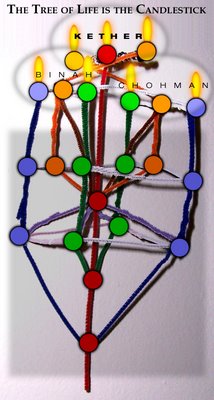 To help clarify the shape for any who haven't been able to discern it from my description and bad pictures, I'll provide a couple additional bad pictures:
To help clarify the shape for any who haven't been able to discern it from my description and bad pictures, I'll provide a couple additional bad pictures:The area above Daath from the "Normal" point of view.
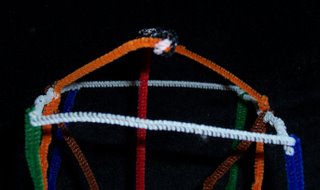
The area above Daath viewed from the side.
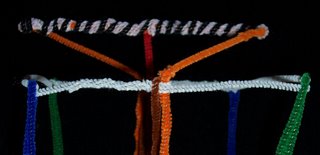 The striped "bar" is not actually a path, but represents the union of these three energies which are combined to form the Kether. Notice how well illuminated all of the branches are from this perspective. Two blue, two green, and two orange, all shining down through the vail.
The striped "bar" is not actually a path, but represents the union of these three energies which are combined to form the Kether. Notice how well illuminated all of the branches are from this perspective. Two blue, two green, and two orange, all shining down through the vail.
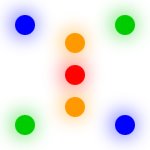 Here I have depicted the tops of the seven lamp stands as seen from above.
Here I have depicted the tops of the seven lamp stands as seen from above.
The following photo is the closest I was able to achieve to the look of a traditional Menorah by photographing my creation from an angle to create the illusion of two sets of branches (green and orange) coming out of each side. The remaining set of branches is coming out the front and back, in line of vision with the central shaft. Ignore the striped bar across the top, and if it only weren't for 3D perspective, the orange branches would not have even look crooked.

Considering it again from the traditional viewpoint, I found it interesting to observe the "thickness" or prominence of each Sephirot with this arrangement. The "F" indicates "Flame" and the number is how many sets of ornaments:
Well, I hope I haven't bored you. I think this is enough Kabbalah for the moment. Looking forward to hearing comments and interpretations on this one.
 The striped "bar" is not actually a path, but represents the union of these three energies which are combined to form the Kether. Notice how well illuminated all of the branches are from this perspective. Two blue, two green, and two orange, all shining down through the vail.
The striped "bar" is not actually a path, but represents the union of these three energies which are combined to form the Kether. Notice how well illuminated all of the branches are from this perspective. Two blue, two green, and two orange, all shining down through the vail. Here I have depicted the tops of the seven lamp stands as seen from above.
Here I have depicted the tops of the seven lamp stands as seen from above.The following photo is the closest I was able to achieve to the look of a traditional Menorah by photographing my creation from an angle to create the illusion of two sets of branches (green and orange) coming out of each side. The remaining set of branches is coming out the front and back, in line of vision with the central shaft. Ignore the striped bar across the top, and if it only weren't for 3D perspective, the orange branches would not have even look crooked.

Considering it again from the traditional viewpoint, I found it interesting to observe the "thickness" or prominence of each Sephirot with this arrangement. The "F" indicates "Flame" and the number is how many sets of ornaments:
3F
2F,1 ... 2F,1
3 ... 3
1
2 ... 2
1
1
2F,1 ... 2F,1
3 ... 3
1
2 ... 2
1
1
Well, I hope I haven't bored you. I think this is enough Kabbalah for the moment. Looking forward to hearing comments and interpretations on this one.




0 Comments:
Post a Comment
<< Home